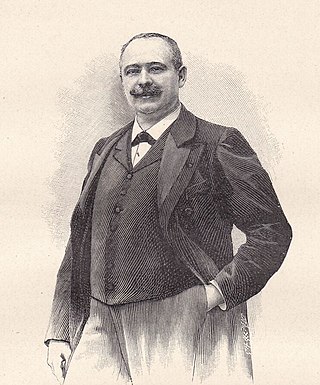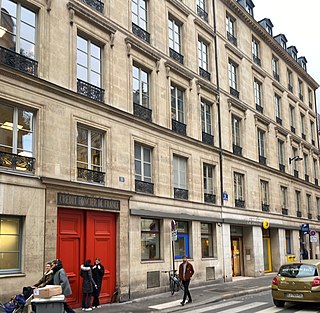
Joseph Jean Pierre Laurent was a French amateur astronomer and chemist who discovered the asteroid 51 Nemausa in 1858, for which he was a recipient of the Lalande Prize awarded by the French Academy of Sciences. It is also likely that he is the same person as the person of that name who provided chemistry assistance to photography pioneer André-Adolphe-Eugène Disdéri in 1853.

The Compagnie des chemins de fer de l'Est, often referred to simply as the Est company, was an early French railway company. The company was formed in 1853 by the merger of Compagnie du chemin de fer de Paris à Strasbourg, operating the Paris-Strasbourg line, and Compagnie du chemin de fer de Montereau à Troyes. In 1938 it became part of the majority state-owned Société Nationale des Chemins de fer Français (SNCF).

Émile Pereire and his brother Isaac Pereire were major figures in the development of France's finance and infrastructure during the Second French Empire. The Pereire brothers challenged the dominance of the Rothschilds in continental European finance, known at the time as haute finance. Their attempt was temporarily successful, and even though it collapsed in the late 1860s, it contributed to a more developed and vibrant economic landscape. Like the Rothschilds, the Pereires were Jews, but unlike them, they were Sephardi of Portuguese origin.

The Marseille Metro is a rapid transit system serving Marseille, France. The system comprises two lines, partly underground, serving 31 stations, with an overall route length of 22.7 kilometres (14.1 mi). Line 1 opened in 1977, followed by Line 2 in 1984. Two stations, Saint-Charles and Castellane, each provide interchange between lines.

Jean Paul Louis François Édouard Leuge-Dulaurier was a French Orientalist, Armenian studies scholar and Egyptologist.

The Rue de l'Arbre-Sec is an old street located in the 1st arrondissement of Lyon, near the Place des Terreaux and the Opera Nouvel. It starts perpendicular to the rue Édouard-Herriot and ends with the Quai Jean Moulin crossing the rue de la République. The name dates from the 14th century and was probably chosen because of a dry tree that could be seen in this street and of an inn sign.
Michel Auguste Martin Agénor Azéma de Montgravier was a French archaeologist and soldier.

Bernard Auguste Rives, known as Gustave Rives (1858–1926), was a French architect of the late 19th and early 20th centuries who designed residential, institutional, and commercial buildings in France in a style described as "opulent eclecticism." He organized many popular auto and aeronautical shows in Paris before the First World War.

Charles-Marie Denys, comte de Damrémont was a French general and military governor of French Algeria. He was killed in combat during the siege of Constantine.

Jean-Baptiste Pastré was a French banker and arms-dealer from Marseille. A merchant banker in Egypt, he founded the Anglo-Egyptian Bank in 1862. He also served on the City Council of Marseille.

The Terrasses du Port is a commercial shopping center situated in the 2nd arrondissement of Marseille. The retail format contains 190 shops, including both domestic and international brands. The mall, which opened in the spring of 2014 also sports a balcony of 2,600 square meters, offering a view of the port, La Joliette, hence the building's name, which translates to "The Port Terraces".

Gustave Foëx was a French ampelographer and a colleague of Pierre Viala.
Théodore Anne was a French playwright, librettist, and novelist.
Fernand Desnoyers, full name Félix-Emile-Arthur Desnoyers, was a 19th-century French writer and literary critic.

Édouard Fournier was a French homme de lettres, playwright, historian, bibliographer and librarian.

Louis Jules César "Louis-Jules" Bouchot was a 19th-century French architect responsible in particular for the construction of the Nice and Milan railway stations.

The Comité Central des Houillères de France was an industrial lobby group that represented the interests of the owners of coal mines. It was active between 1887 and 1940, when the Vichy government dissolved it and placed the coal industry under government control.

Jules–Auguste Lair was a French lawyer, businessman and scholar. At the École des Chartes he studied palaeography, and was offered a position with the Archives, but he decided instead to become a lawyer. At the age of 25 he became director of a warehousing company, and over the next forty years was involved in various major enterprises including the first telephone network in France. At the same time, he always set aside time for historical work, and published many articles and books on aspects of French history from the Middle Ages to the French Revolution.
Thiers is a neighbourhood of the 1st arrondissement of Marseille. A cultural and student quarter in the centre of Marseille, it is located between Place Jean-Jaurès and La Canebière, near the Vieux-Port.

The Compagnie Algérienne, from 1942 to 1948 Compagnie Algérienne de Crédit et de Banque, was a significant French bank with operations in Algeria, Morocco, Tunisia and Lebanon as well as mainland France. It was formed in 1877 in a restructuring of its predecessor entity, the Société Générale Algérienne, itself founded in 1865-68. The Compagnie Algérienne eventually merged in 1960 with the Banque de l'Union Parisienne. Following a series of subsequent restructurings, its main successor entities as of 2022 are the Crédit du Nord in France, the Crédit populaire d'Algérie in Algeria, the Banque de Tunisie in Tunisia, Attijariwafa Bank in Morocco, and the Banque Libano-Française in Lebanon.

















